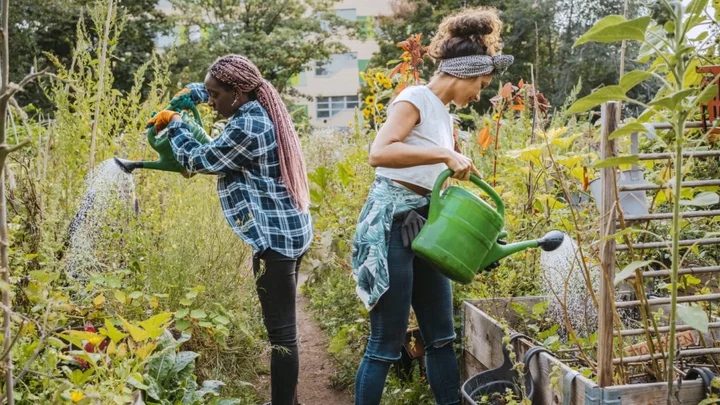Gardens bring great joy, keep us close to nature, and have a positive, calming impact on our lives. They do, however, require a fair amount of TLC. Knowing how often to water your garden can help keep your plants healthy and vibrant throughout the growing season.
- How much water does a garden need?
- How to Tell If Your Garden Is Getting Enough Water
- Why Your Local Climate Matters
- How to Determine Your Garden’s Soil Type
- Why Newer Plants Need More Water
- How Native Plants Can Benefit Your Garden
- The Best Time to Water Your Garden
Despite the general guidelines, each garden is unique, and there are several factors that can influence how often you need to water yours. Once you’ve learned a few key things about your garden’s plants, you’ll know how often you should grab a hose and help them out.
How much water does a garden need?
Watering your plants is not a one-size-fits-all scenario. If you’re growing vegetables or flowers, most people suggest making sure your garden gets one inch of water a week. Calculating the right amount isn’t too tricky: One square foot of garden space would need 0.62 gallons of water to make the recommended inch of water; you can simply calculate the amount of water your garden would need based on its square footage from there.
It’s easy to measure with a watering can, but not so easily done when watering with a hose. You could fill a gallon watering can with a hose while calculating much time it takes to fill it. You’ll then know approximately how long to water with the hose to get the recommended amounts per square foot of garden area. The key is to water your garden well with deep, less frequent watering rather than more frequent shallow watering (a shallow soak won’t reach the roots as well).
How to Tell If Your Garden Is Getting Enough Water
Even with a solid watering schedule, you should check the soil often to make sure your garden is getting enough water (and not too much!). It’s as simple as feeling the soil. If you can make a moist ball with the soil in the palm of your hand, it’s watered enough. If it starts to fall apart or feels cracked and hard, it will need some additional watering.
You can also measure your garden’s water levels by inserting a wooden dowel into the ground. Soil that is wet enough will stick to the dowel; dry soil, on the other hand, won’t. The soil should be moist, but you should also take care to avoid overwatering—this may kill your plants.
Your fingers will come in handy too. Stick your finger a few inches into the soil, and if it feels dry, go ahead and get your watering can.
Why Your Local Climate Matters
Is your region’s climate hot and arid, or is it cooler with frequent rain showers? The more hot, sunny, and dry days you have during the growing season, the more often your garden may need an extra dose of water. Following heavy rains, you may be able to ease up on the watering for a few days. Keep in mind that light rain showers generally aren’t enough to keep the soil moist—most of that water will evaporate before it gets the chance to penetrate the soil to the root level.
How to Determine Your Garden’s Soil Type
The type of your soil is an important factor in determining how often you should water your plants. There are several types of soil gardeners will encounter, including sand, clay, and loam. Each of them has a range of water retention abilities you’ll want to know when considering how often to water. Sandy soil retains less water than loamy or clay soils, therefore it dries out faster, requiring more frequent hydration. Clay-rich soil holds moisture longer, but because of this, could be more susceptible to overwatering. Loam is typically the ideal garden soil because it both holds moisture and drains well.
There’s a simple soil test you can do to determine which type you have in your garden. Just make a “mudshake” by filling a jar with soil and water. Shake it up, then let the jar sit overnight and see how the soil settles; different types will react differently within the water. Once you know your garden soil type, you can better plan a more efficient watering schedule.
Why Newer Plants Need More Water
Newer plants need more water as they work on establishing strong root systems. With their underdeveloped roots, very young plants or newly planted flowers are sensitive to environmental factors and may become easily dehydrated. Mature plants are more resilient and can go longer stretches without watering.
Some plants and flowers require less water than others regardless of their age. Does your garden feature hardy, drought-resistant plants, is it full of moisture-loving flora, or do you have a range of plants with different needs? If you are still unsure about it, stick to this rule of thumb—water your plants when the soil starts to feel dry to your touch.
How Native Plants Can Benefit Your Garden
Adding a variety of native plants will enhance your garden and make the chore of watering a little bit easier. Flora native to your area have adapted to the local climate, soil types, and amount of rainfall with little human intervention, making them less dependent on watering, thereby saving you both water and time. Native plants are also excellent environmentally friendly choices with deep root systems that anchor the soil, reduce erosion, and decrease the amount of excess water that ends up in storm drains and runoffs.
As valuable as native plants are to our water conservation efforts, they also play an important role in preserving the natural habitats of local wildlife and providing sustenance and shelter to pollinators, birds, and other animals. Including native plants in your garden is a win for both water consumption and local conservation efforts.
The Best Time to Water Your Garden
When you do bust out that hose for a watering session, make sure it’s in the early morning or evening (though early morning is best). Watering in the hours before the sun rises too high allows your plants to retain more moisture. If you can’t do it in the early morning, water in the early evening. Avoid watering your garden in the middle of the day, as this leads to water evaporating before it can reach the plants’ roots.
Related Tags
WATER PLANTS FLOWERS LIVE SMARTER ENVIRONMENT NATURE SPACE WORK








